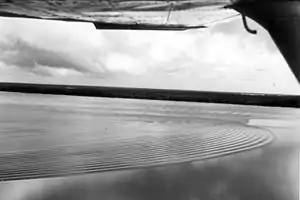Araguari River (Amapá)
The Araguari River (Portuguese: Rio Araguari) is the primary river of Amapá state in north-eastern Brazil. It became famous among surfers when some decided to ride its constant tidal bore, characterizing waves that can last for several minutes.[2] In 2013, three dams were built in the river to generate hydroelectricity. The dams ended the tidal bore which altered the flow of water in the Amazon, and caused significant land erosion and damage to the Bailique Archipelago.[3]

Undular bore and whelps near the mouth of Araguari River. View is oblique toward mouth from airplane at approximately 100 ft (30 m) altitude.[4]
| Araguari River | |
|---|---|
 Araguari River in Cutias | |
 | |
| Native name | Rio Araguari (Portuguese) |
| Location | |
| Country | Brazil |
| Physical characteristics | |
| Source | |
| • location | Amapá state |
| Mouth | |
• location | Atlantic Ocean |
• coordinates | 1.25°N 49.916667°W |
| Length | 560 kilometres (350 mi)[1] |
| Basin size | 42,712 square kilometres (16,491 sq mi) |
| Basin features | |
| Tributaries | |
| • left | Mutum River, Falsino River |
The river flows through the Uatuma-Trombetas moist forests ecoregion.[5] The river defines the western boundary of the 460,353 hectares (1,137,560 acres) Amapá National Forest, a sustainable use conservation unit created in 1989.[6]
See also
References
Wikimedia Commons has media related to Araguari River (Amapá).
- Ziesler, R.; Ardizzone, G.D. (1979). "Amazon River System". The Inland waters of Latin America. Food and Agriculture Organization of the United Nations. ISBN 92-5-000780-9. Archived from the original on 8 November 2014.
- Surfers Village "Big-Wave Tow-in surfers on mile-long Pororoca wave" Archived 2013-08-31 at the Wayback Machine
- "Bailique: Why these islands in the Amazon Delta are falling into pieces". Monga Bay (in Portuguese). Retrieved 4 April 2021.
- Figure 5 in: Susan Bartsch-Winkler; David K. Lynch (1988), Catalog of worldwide tidal bore occurrences and characteristics (Circular 1022), U. S. Geological Survey
- Sears, Robin, Northern South America: Northeastern Brazil, into southern Guyana and Suriname (NT0173), WWF: World Wildlife Fund, retrieved 2017-03-31
- FLONA do Amapá (in Portuguese), ISA: Instituto Socioambiental, retrieved 2016-07-06
This article is issued from Wikipedia. The text is licensed under Creative Commons - Attribution - Sharealike. Additional terms may apply for the media files.